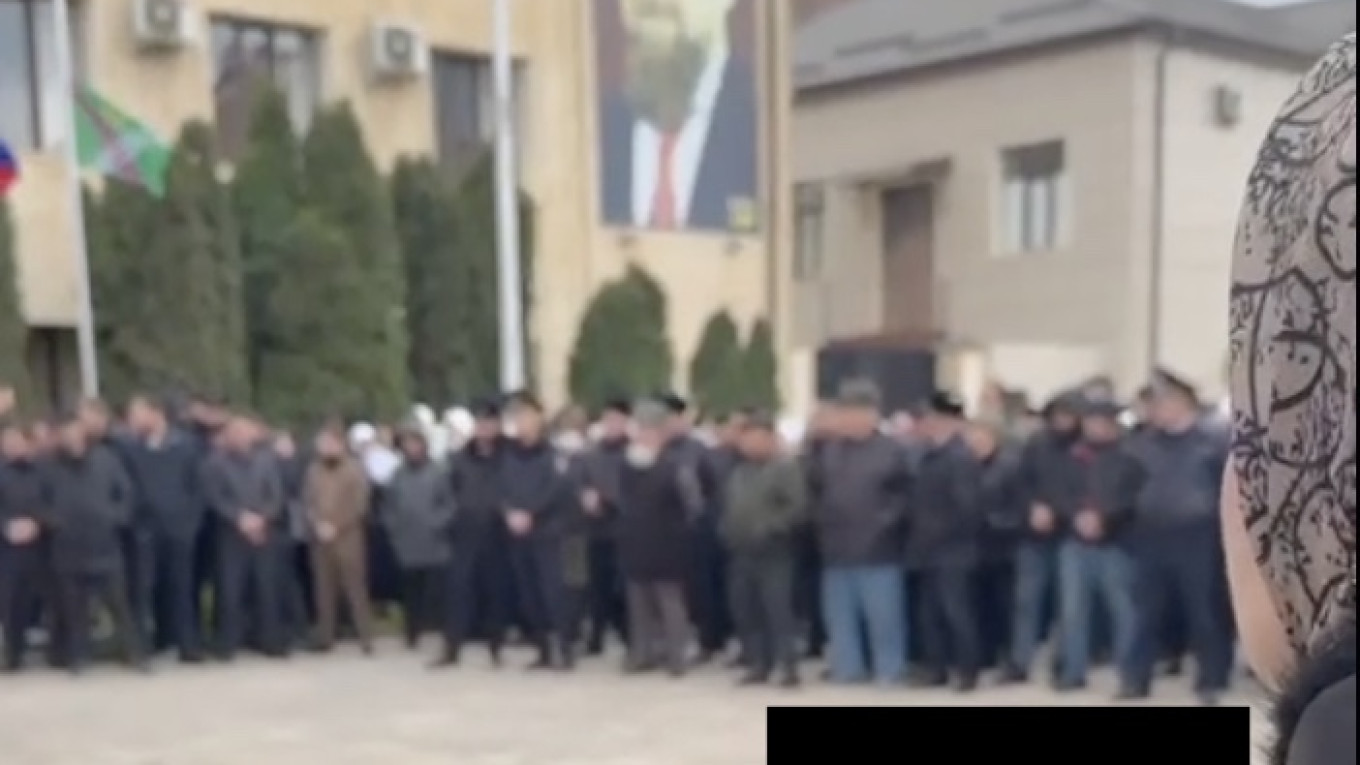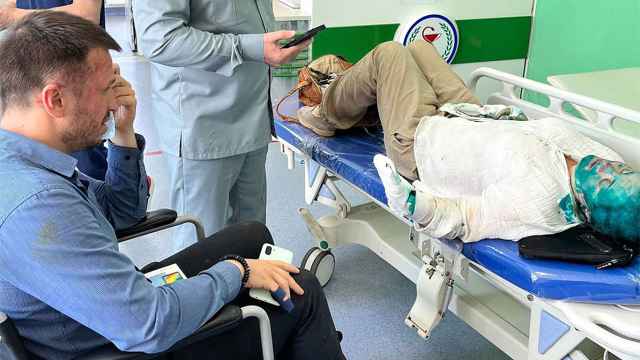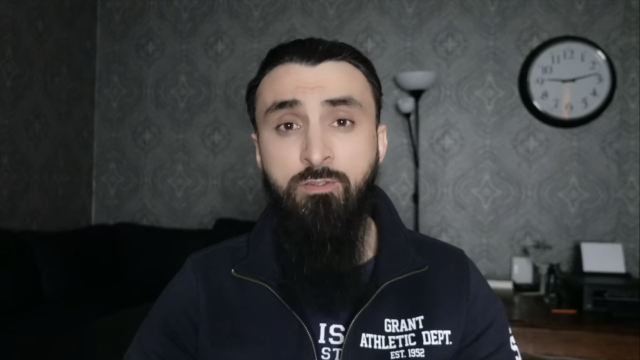For Russians and Chechens who followed the news on social media, this April began with extremely shocking news that revealed an important cultural conflict between Chechens and their Moscow-imposed leadership.
On the evening of April 7, a young man attacked patrol officers with a knife, leaving one dead, in the small Chechen town of Achkhoy-Martan. The suspect, 17-year-old Eskarhan Khumashev, was executed without any trial or investigation.
Two days later, the teenager’s corpse was put on display in the city square, and Ramzan Kadyrov, the leader of the de facto Russian occupational administration in Chechnya, launched a punishment campaign, ordering the kidnapping of the boy’s relatives and demanding that the attacker’s family be expelled from Chechnya. Even 13-year-olds were reportedly among those kidnapped.
Eskarhan’s relatives, as well as public servants, including teachers, were forced to watch the corpse in the street and participate in a public shaming. Even local schoolchildren were forced to witness the aftermath of the execution.
According to a report by Chechen opposition outlet NYISO, Eskarhan Khumashev got into an altercation with 26-year-old Islam Vakhayev, an employee of the Achkhoy-Martan Police Department, the day before the fatal attack. Locals knew Vakhayev as someone who tortured people and was described as extremely vile and cruel.
According to Djambulat Suleimanov, a Chechen historian and leader of the Chechen liberation group United Force, Khumashev was not a radical with some international connection, as the administration said. "He was just a hot-headed teenager who had a conflict with a policeman known for his harsh behavior. The boy ran off and came back with a knife. We all know what happened after.”
But this is not just about one single act committed by a teenager who died after attacking a policeman, or even about the disproportionately harsh reaction from the Russian administration in Chechnya. The events in Achkhoy-Martan revealed the clash of civilizations between Russians and Chechens, ignored by people outside the republic and the unintentional rise of a new symbol of public grievances.
Russian-language outlets mostly portray the situation as a reflection of Chechens’ supposed brutality and barbarism. Meanwhile, for Chechens, it symbolizes Russian occupation. As I mentioned in my previous article, Ramzan Kadyrov is not a legitimate leader of Chechnya. He is a Moscow-backed bureaucrat imposed on Chechens during the war, and he is deeply hated by the local population.
I spoke with a young Chechen man to gauge the mood among Chechen people. The Moscow Times is keeping hin anonymous for security purposes.
“Everyone understands that he was forced on us by the Kremlin, that no one chose him,” he said. “Russians have always used the same tactic against Chechens — from the Tsarist Empire, when Russians displayed the body of Chechen freedom fighter Abrek Zelemkhan, taking pictures of him and making his relatives, including women and children, pose near his dead body. It continued in Soviet times. And during the Russian-Chechen wars, Russians often displayed and humiliated the bodies of Chechen fighters. It has a long history, all done in the name of terror.”
There is nothing new in Kadyrov’s tactics. They are rooted in the tactics of Russian military aggression, not Chechen culture, and the Chechen people know it. One of the first things I learned about Chechen culture when I started studying it is that the Chechens have always been extremely respectful toward their dead and have very clear rules about how to behave with enemies, as pointed out even by Western academics.
Speaking with Chechens of different generations and following Chechen activists online, it is impossible to ignore how they interpret these events in ways that outsiders often fail to recognize.
“Kadyrov’s administration is trying to change our customs,” Djambulat Suleimanov said. “In our traditions, even during blood revenge, you couldn’t kill your nemesis in front of women and children, in their house, or in your own house. Children should never witness things like that, so as not to be traumatized, and Kadyrov made women and kids watch the dead body. Historically, even during blood vengeance, you had to cover the body carefully and tell your enemy’s relatives where to find it.”
Suleimanov thinks that the display may have backfired. “When you see the video from Achkhoy-Martan, you see that the executioners played a cruel joke on themselves. Young women are crying and cursing a world that allows adolescents to be treated like this. It is not something Chechens can forget or forgive. And it’s not the first time something like this has happened. Everyone involved in Chechen politics remembers how Kadyrov’s administration tortured, raped and killed 19-year-old Salman Tepsuraev, the moderator of the 1Adat Telegram Channel.”
In some ways, Eskarhan Khumashev became a symbol for Chechens online: If not a symbol of resistance, then at least a symbol of the unlawful treatment Chechens face under Russian control. By attempting to break anti-government resistance through a public execution, Kadyrov’s officials only made themselves look even more antithetical to Chechen tradition and pushed a new generation of Chechens to view Russian rule with even greater skepticism — if that was even possible.
The Kadyrov government’s intimidation techniques may stop people from speaking publicly for fear of endangering their relatives. But they have also created deeper resentment and hatred.
For Chechens, the incident in Achkhoy-Martan was a demonstration of Russian power over Chechnya. Meanwhile, to Russian outlets and activists, including some Russian opposition figures, it looks like an internal Chechen conflict, based on Chechen traditions and carried out by Kadyrov’s administration, which they claim refuses to support Russian law. These are diametrically opposed views of what happened and who is to blame: Russia as an occupying power, or a local dictator representing a small nation.
Until Chechen voices are heard in conversations about current events in the republic, such atrocities will not be stopped and international observers will never understand what is going on in the republic.
A Message from The Moscow Times:
Dear readers,
We are facing unprecedented challenges. Russia's Prosecutor General's Office has designated The Moscow Times as an "undesirable" organization, criminalizing our work and putting our staff at risk of prosecution. This follows our earlier unjust labeling as a "foreign agent."
These actions are direct attempts to silence independent journalism in Russia. The authorities claim our work "discredits the decisions of the Russian leadership." We see things differently: we strive to provide accurate, unbiased reporting on Russia.
We, the journalists of The Moscow Times, refuse to be silenced. But to continue our work, we need your help.
Your support, no matter how small, makes a world of difference. If you can, please support us monthly starting from just $2. It's quick to set up, and every contribution makes a significant impact.
By supporting The Moscow Times, you're defending open, independent journalism in the face of repression. Thank you for standing with us.
Remind me later.






